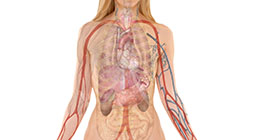
Deep Breathing
In ayurvedic medicine, the traditional Indian healing system, breathing represents more than just Westernized ideas of increasing lung capacity and blood oxygen. It involves a transfer of energy, a healing exchange with our environment and the greater universe. What a wonderful and appropriate concept when it comes to the health of the heart, an organ that responds to forgiveness, love, laughter, happiness, and joy.
It goes without saying that everybody breathes; without air pumping in and out of the lungs to distribute throughout the body, we would be in trouble. Yet most people do not give thought to how they breathe.
Do this quick test now. Sit comfortably on a chair. Place one hand on your chest, the other on your belly. Breathe several times. If your chest-bound hand moves more than your belly hand, you are what is known as a thoracic breather; if your belly-bound hand moves more than your chest-bound hand, you are a belly breather. Belly – or diaphragmatic – breathing is what we instinctively did as babies. Besides providing more oxygen to the system, it also allows us to expel more carbon dioxide wastes. Most of us expand our chests when we breathe, which elevates our shoulders and is, in fact, a relatively shallow way of inhaling. Better breathing — belly breathing — pushes the abdomen in and out more forcefully, pumping more oxygen into our system.
Tuning in to how we breathe requires mindfulness and practice — mindfulness in recognizing our breathing patterns and how they change (e.g. during times of stress), and the practice to correct any unhealthy ones. One advantage to deep breathing is that you can ease into it any time, any place, anywhere — and the only person who has to know is you. Whether it is during a meeting or in a disagreement with a loved one, there is no wrong time to take a moment, reflect, then purposefully adjust. This breathing mechanism also encourages us to tune in to our bodies in general. Human beings, and women in particular, often miss those subtle messages that are being sent from within.
Mindful breathing is a habit to cultivate as much as possible. Do it daily, at whatever time and in whatever form suits you. The general rule is breath in and out through your nose (not your mouth). Breathe deeply and regularly, eyes closed, with intention and inward focus. Some people find that it helps to envision the breathing as waves, encroaching and receding.
Set the Relaxation Stage
Create your special place. It could be an unused room in your house, a sunny spot in the front yard, or a cushioned corner of your bedroom. Anywhere away from the phone or TV will do. Designate this area for relaxation and use it routinely.
Comfort first. Who can relax if you are taut with tension and holding yourself upright? Choose a comfortable chair, a pillowed seat on the floor, or whatever works for you. Your clothing should be equally unconstrained.
Time it out. Insomniacs are often encouraged to create bedtime routines. Likewise for relaxation. Choose a time of day that works for you and create a relaxation routine. Do your best to stay regular, but if you cannot, do not inwardly beat yourself up about it.
Practice, practice, practice. Routine relaxation, once per day or more, will induce the best overall effect. You will become attuned to your body, mind and emotions, while simultaneously lowering your blood pressure and heart rate, and protecting against stress effects.
Forgive your wandering mind. Learning to relax is like any other skill. It takes practice. As you try to focus inwardly, you will find your mind drifting to random thoughts. Your internal self is a chatterbox. Rather than fight these spurts, allow them to form, then let them go and refocus. Accept your own role in the process. Do not judge yourself, and you will find that relaxation comes to you.
Breathing exercise 1
Close your eyes. Whisper “ha” and feel the sound as it resonates in the back of your throat.
Close your mouth and breathe in through your nose, regularly and smoothly. As you breathe in, feel the air striking the back roof of your mouth.
Exhale while silently vocalizing the “ha” sound, experiencing it resonate in your throat. Your breath should be light, unforced, like gentle snoring.
Place your hand on your belly to ensure belly breathing (versus chest breathing). On the exhale, contract your belly muscles to ensure all air is expelled.
Repeat for two or three minutes.
Breathing exercise 2
This one is great at work. Sit at your desk, your back straight, feet flat on the floor.
Eyes closed, inhale slowly and deeply, focusing on the expansion of your belly (leave your hand on your belly if necessary). As you exhale slowly through your nose, make a low humming sound in your throat.
Repeat for two to three minutes.
Breathing exercise 3
The key to this one is in the exhalation. Exhale and inhale fully as per breathing exercise 1. Then, using your abdominal muscles, exhale spurts of air at a rate of about two per second. Exhale forcefully but with control about fifteen times. If you experience discomfort, reduce the exhalations or resume your normal breathing.
Repeat three cycles interspersed with cycles of breathing exercise 1. Always finish with a full, gentle exhale, inhale, exhale.
If ever you feel dizzy, return to your normal breathing until you feel better. Always finish with a few moments of relaxing to transition back into the real world. Some people may experience a slight light headedness, so wait peacefully until it passes.
Simple Meditation Exercise
Sit somewhere quiet and peaceful where you will not be disturbed and are less likely to be distracted. Use a chair or flat pillow.
Calm your mind with a few diaphragmatic breaths. Focus on your breathing, the in and out movement of your belly.
If you prefer, mentally focus on a neutral word or phrase, e.g. Love, Live, Peace, Joy, Relax. Words to avoid include those that sound like commands, e.g. Go, Stop, Wait.
Your mind may wander, especially as you are learning your technique. Allow it to happen, then return your attention to your breathing or word.
During this time, not just thoughts but judgements, sensations, images, memories and desires might arise. Acknowledge them, accept them as part of the process, then refocus on your breathing. Without force, these random distractions will disappear by themselves.
Set an alarm clock nearby to keep you on track. Start with 5 minutes.
Gradually continue your meditation time until you are at 20 minutes.
Meditate Stress Away
You do not have to sit on a rock, or be cross-legged and bald, to meditate. The practice of meditation has evolved past old stereotypes into a modality with applications well-suited to modern life. You may recall that depression is one of several psychosocial factors that increases the risk of heart disease. In 2009, the first large clinical trial investigated the effect of psychosocial intervention on the heart. Two hundred and eight patients with heart failure were followed for a year after eight weeks of training in meditation, coping skills and support group discussion. Compared to a control group, the participants reported lower anxiety and depression, and improved symptoms of heart failure, even at the one year mark.
The combination of meditation and breathing generated positive effects in a recent randomized pilot trial involving 52 patients who did not receive pharmaceutical treatment for high blood pressure. Those who underwent eight weeks of meditation and breathing techniques “induced clinically relevant and consistent decreases in heart rate, systolic and diastolic blood pressure.” A 2006 study noted that yoga with meditation improved endothelial function in people with coronary artery disease, and that this combination resulted in significant reductions in blood pressure, heart rate and body mass index in the 33 subjects, whether they had existing heart disease or not. In a randomized, controlled trial of 103 heart disease patients, transcendental meditation for 16 weeks improved blood pressure, insulin resistance and cardiac autonomic nervous system tone compared to a control group receiving health education.













